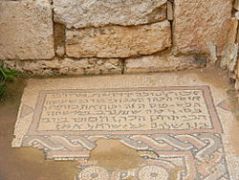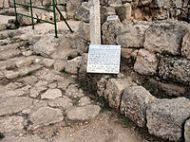Susya, in the Southern Hebron Hills region, was home to what may have been quite an enigmatic Jewish community for hundreds of years. Not mentioned in Rabbinic texts, it was settled in the Byzantine era.
Its synagogue has one of the best kept mosaics from Jewish Eretz Israel at the time:
It is a transverse synagogue, meaning its entrance is on the east side while the synagogue faces north. Such is the case for other synagogues in the region as well. The only known transverse synagogue where the entrance faces east but the direction faces south was found in Hammat Gader. The source for an eastern entrance regardless of the direction of prayer is a Tosefta in Mesechet Megillah (3:14), due to the fact that the entrance to the Heichal of the Temple was in the east.
What makes Susya most unique is the large amount of mikvaot discovered there.
28 have been discovered to date, and the site has only been partially excavated.
Why was there such a need for so many mikvaot? During the Second Temple period, as well the period between the Great Revolt and that of Bar Kochva, ritual purity was a focal point of Jewish observance. These required all who came into contact with the dead to be purified by the ashes of the para aduma . It is likely that the many of the ashes survived the Great Revolt but not that of Bar Kochva. Hence most Jews were unable to be ritually pure anyway, and as a result the need for mikvaot in the country as a whole was drastically reduced.
The only other sites with large amounts of post-Bar Kochva mikvaot discovered are Tziporri and Bet Shearim. Although it can’t be determined at what point these mikvaot, that were continuously settled from the second century until the middle of the fourth, fell into disuse, Ulah’s comment (Chagiagah 25a) that “there are those who purify themselves in the Galil” indicates that some individuals in the north still had access to the ashes of the para adumah at the end of the 3rd century. The fact that the Talmud Yerushalmi doesn’t have any Gemara for Seder Taharot (besides several chapters of Niddah) indicates that these laws were no longer relevant as a whole in the Amoraic period.
Susya was only settled – and its mikvaot built – in the fourth century, long after we have no record of ritual purity being practiced anywhere. Moreover, it isn’t clear when these mikvaot fell into disuse. In his dissertation Dr Yonatan Adler entertains the possibility that ritual purity was kept in its entirety in this remote hamlet until the Arab period in the seventh century!
Another possibility is that this town, whose mosaic indicates a large amount of Kohanim, continued to immerse before eating even though they were ritually impure due to the lack of Para purification. Dr. Doron Sar Avi claims that the reason why the transverse synagogues were popular in the South Hebron hills region is because the dearth of Sages in the area resulted in a more traditional society which lacked the dynamic Halacha which evolved in the North and in “Babylonia”. This may also be the reason why mikvaot were in use in Susya for immersions that may have been Halachicly irrelevant.

 One of Susya’s many Mikvaot
One of Susya’s many Mikvaot
Great Eli! This is my favorite place in E-Y!
Very interesting! Thanks for writing it.
Didn’t realize there were a plethora of mikvaot in Beit Shearim. I know of one; where are the others? I love Sussiya also; fascinating site. Do you have any thoughts on whether there was a zodiac mosaic there?